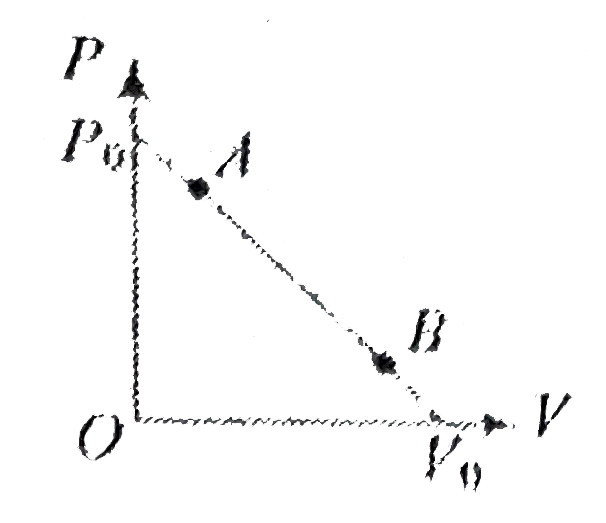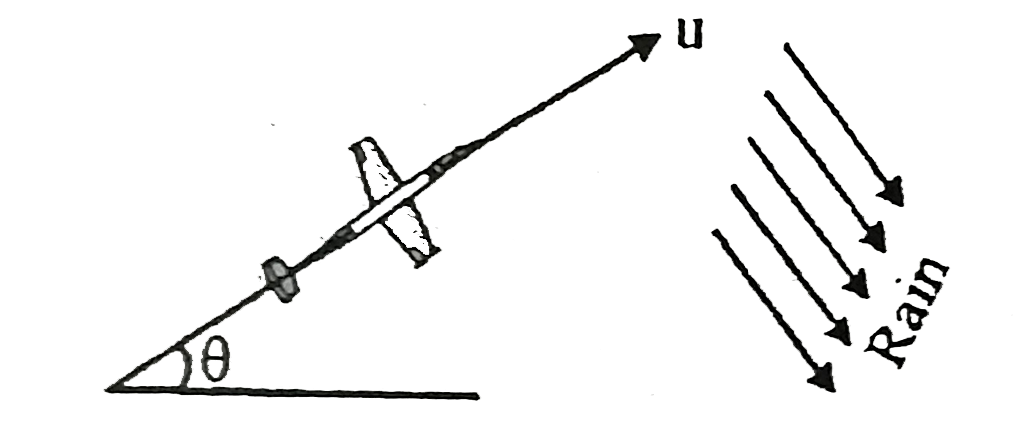A man moving with 5ms−1 observes rain falling vertically at the rate of 10ms−1. Find the speed and direction of the rain with respect to ground.
To solve the problem of finding the speed and direction of the rain with respect to the ground, we can follow these steps:
Step 1: Understand the given information
- The man is moving with a velocity Vm=5m/s horizontally.
- The rain is observed to be falling vertically with a velocity Vrm=10m/s with respect to the man.
Step 2: Set up the relative velocity equation
The relative velocity of the rain with respect to the man can be expressed as:
→Vrm=→Vr−→Vm
where →Vr is the absolute velocity of the rain with respect to the ground, and →Vm is the velocity of the man.
Step 3: Break down the velocities into components
- The velocity of the man →Vm can be represented as:
→Vm=5m/s^i
(where ^i is the horizontal direction).
- The velocity of the rain with respect to the man →Vrm is:
→Vrm=0^i−10^j
(where ^j is the vertical direction).
Step 4: Substitute into the relative velocity equation
From the relative velocity equation:
→Vrm=→Vr−→Vm
we can rearrange it to find →Vr:
→Vr=→Vrm+→Vm
Substituting the values:
→Vr=(0^i−10^j)+(5^i)=5^i−10^j
Step 5: Calculate the magnitude of the rain's velocity
The magnitude of →Vr can be calculated using the Pythagorean theorem:
|→Vr|=√(5)2+(−10)2=√25+100=√125=5√5m/s
Step 6: Determine the direction of the rain's velocity
To find the angle ϕ that the rain makes with the vertical, we can use the tangent function:
tan(ϕ)=VmVrm=510=12
Thus, we can find ϕ:
ϕ=tan−1(12)
Final Answer
The speed of the rain with respect to the ground is 5√5m/s and it falls at an angle ϕ=tan−1(12) from the vertical.
---
- The man is moving with a velocity Vm=5m/s horizontally.
- The rain is observed to be falling vertically with a velocity Vrm=10m/s with respect to the man.
The relative velocity of the rain with respect to the man can be expressed as:
→Vrm=→Vr−→Vm
where →Vr is the absolute velocity of the rain with respect to the ground, and →Vm is the velocity of the man.
- The velocity of the man →Vm can be represented as:
→Vm=5m/s^i
(where ^i is the horizontal direction).
- The velocity of the rain with respect to the man →Vrm is:
→Vrm=0^i−10^j
(where ^j is the vertical direction).
From the relative velocity equation:
→Vrm=→Vr−→Vm
we can rearrange it to find →Vr:
→Vr=→Vrm+→Vm
Substituting the values:
→Vr=(0^i−10^j)+(5^i)=5^i−10^j
The magnitude of →Vr can be calculated using the Pythagorean theorem:
|→Vr|=√(5)2+(−10)2=√25+100=√125=5√5m/s
To find the angle ϕ that the rain makes with the vertical, we can use the tangent function:
tan(ϕ)=VmVrm=510=12
Thus, we can find ϕ:
ϕ=tan−1(12)
The speed of the rain with respect to the ground is 5√5m/s and it falls at an angle ϕ=tan−1(12) from the vertical.
Topper's Solved these Questions
- BOOK - CENGAGE PHYSICS ENGLISHCHAPTER - KINEMATICS-2EXERCISE - Solved Examples7videos
KINEMATICS-2
- BOOK - CENGAGE PHYSICS ENGLISHCHAPTER - KINEMATICS-2EXERCISE - Exercise 5.115videos
KINEMATICS-2
- BOOK - CENGAGE PHYSICS ENGLISHCHAPTER - KINEMATICS-1EXERCISE - Integer9videos
KINEMATICS-1
- BOOK - CENGAGE PHYSICS ENGLISHCHAPTER - KINETIC THEORY OF GASESEXERCISE - Compression2videos
KINETIC THEORY OF GASES
Similar Questions
Two towers AB and CD are situated at a distance d apart, as shown in figure. AB is 20 m high and CD is 30 m high from the ground. An object of mass m is thrown from the top of AB horizontally with a velocity of 10 m/s towards CD. Simultaneously another object of mass 2 m is thrown fromt the top of CD at an angle of 60∘ to the horizontal towards AB with the same magnitude of initial velocity as that oft he first object. The two objects move in the same vertical plane, collide in mid air and stick to each other (i) calculate the distance between the towers and (ii) find the position where the objects hit the ground.
 04:09View Solution
04:09View SolutionThe equation of projectile is y=16x−5x24. Find the horizontal range.
05:06View SolutionA man in a lift ascending with an upward acceleration a throws a ball vertically upwards with a velocity v with respect to himself and catches it after t1 seconds. After wards when the lift is descending with the same acceleration a acting downwards the man again throws the ball vertically upwards with the same velocity with respect to him and catches it after t2 seconds?
05:37View SolutionOne mole of an ideal monatomic gas undergoes a linear process from A to B , in which is pressure P and its volume V change as shown in figure .

The absolute temperature T versus volume V for the given process is04:13View SolutionA man moving with 5 ms^-1 observes rain falling vertically at the rate of 10 m s^-1 . Find the speed and direction of the rain with respect to ground.
01:50View SolutionTo a man going with a speed of 5 ms^-1 , rain appears to be falling vertically. If the actual speed of rain is 10 m s^-1 , then what is the angle made by rain with the vertical ?
View SolutionTo a stationary man, rain appears to be falling at his back at an angle 30∘ with the vertical. As he starts moving forward with a speed of 0.5ms−1, he finds that the rain is falling vertically.
The speed of rain with respect to the stationary man is.01:33View SolutionTo a stationary man, rain appears to be falling at his back at an angle 30∘ with the vertical. As he starts moving forward with a speed of 0.5ms−1, he finds that the rain is falling vertically.
The speed of rain with respect to the moving man is.05:20View SolutionRain is falling with speed 12√2 m//s at an angle of 45∘ with vertical line A man in a glider going at a speed of v at angle of 37∘ with respect to ground find the speed (in m//s) of glider so that rain apears to him falling vertically Consider motion of glider and rain drops in same vertical plane.
 09:43View Solution
09:43View SolutionRain falling vertically is appeared to fall at 37∘ with vertical for a man running on horizontal ground with 8 m/s. What is the speed of rain ( in m/s) relative to ground.
03:47View SolutionA man moving with 5 ms^(-1) observes rain falling vertically at the rate of 10 ms^(-1) . Find speed of the rain with respect to ground.
01:34View SolutionTo a cyclist moving at 5m⋅s−1 , rain appears to be falling vertically at a velocity of 5m⋅s−1. Find the actual magnitude and direction of the velocity of rain.
View SolutionTwo persons A and B are moving along same straight line in opposite directions,each with speed 4m/s with respect to ground.A feels that the rain drops are falling vertically while B feels that rain drops are falling at an angle of 45^(@) with vertical.If the speed of rain with respect to ground is sqrt(p) m/s .Find p.
03:01View SolutionA man moving with 5 m/s observes rain falling vertically at the rate of 10 m/s find the speed and direction of the rain with respect to ground .
01:48View SolutionRain is falling vertically downwards with respect to ground. If a girl running on the ground with speed 3 km/h observes the rain is falling with speed 5 km/h then actual speed of rain is
02:17View Solution

